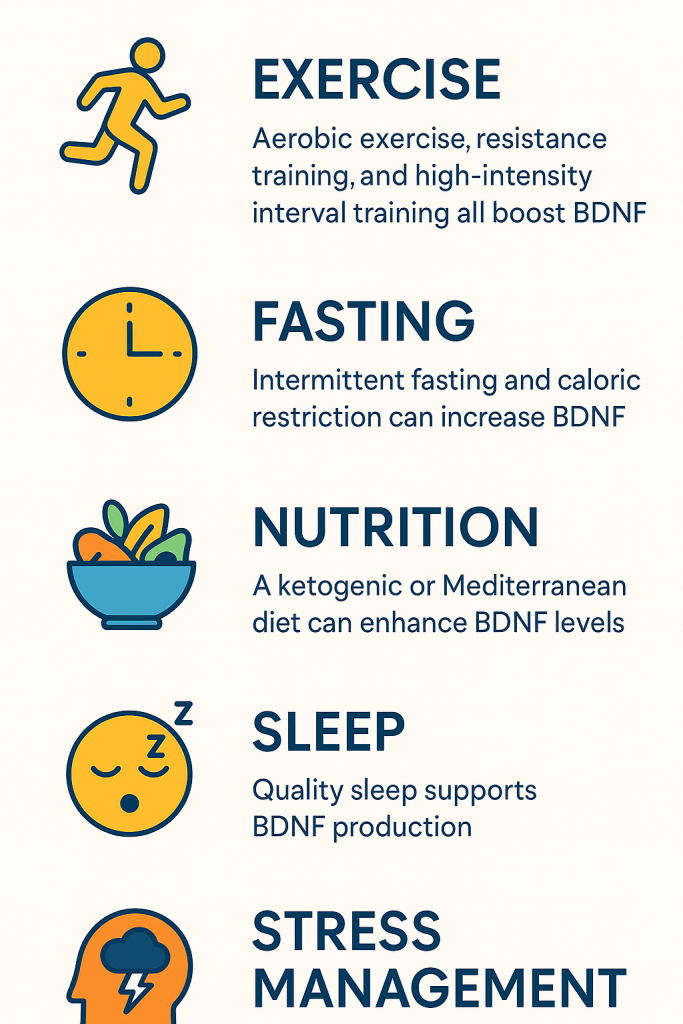Why Brain Growth Matters More Than Ever
We live in an age where mental clarity, focus, and resilience are essential for success. Whether you’re trying to perform better at work, protect your memory as you age, or improve your mood, there’s one molecule that scientists have found to be a game-changer: Brain-Derived Neurotrophic Factor (BDNF).
If you’ve been searching for the most effective ways to increase BDNF, you’re in the right place. This fascinating protein, often called “fertilizer for the brain,” is central to learning, memory, emotional balance, and long-term brain health. Higher levels of BDNF are linked to sharper thinking, better mood regulation, and even protection against neurodegenerative diseases like Alzheimer’s and Parkinson’s.
The best part? You don’t need futuristic brain implants or expensive therapies to increase BDNF. Science has shown that simple, natural habits—things you can do daily—are among the most effective ways to increase BDNF and supercharge your brain’s capacity.
In this comprehensive guide, we’ll explore:
- What BDNF is and why it’s so crucial
- The latest research on how to boost it naturally
- A step-by-step plan to integrate these strategies into your life
What is BDNF, Really?
To understand why raising BDNF is so powerful, let’s take a closer look at what it actually does.
The Basics of BDNF
BDNF is a neurotrophin, a type of protein that helps neurons grow, survive, and form new connections. Think of it as the brain’s version of fertilizer, making your mental “soil” richer and more fertile for new ideas, memories, and skills.
When BDNF binds to its receptor (called TrkB), it activates pathways that promote:
- Neurogenesis – the creation of new brain cells.
- Synaptic plasticity – the strengthening of connections between neurons.
- Neuroprotection – shielding neurons from injury and stress.
Where is BDNF Produced?
BDNF is found throughout the brain, but especially in the hippocampus, the region involved in learning and memory. It’s also present in the cortex and basal forebrain. Interestingly, it’s also detectable in the blood, and studies suggest that blood BDNF levels often reflect what’s happening in the brain.
Why Humans Evolved BDNF
From an evolutionary perspective, BDNF helped us adapt to challenging environments. When our ancestors hunted, fasted, or faced stress, BDNF surged—making the brain sharper, more creative, and resilient in times of need.
Why Increasing BDNF is Essential
You might be wondering: why should I care about my BDNF levels? Here’s why it matters.
1. Mental Health
- Depression: Studies show that people with depression have lower BDNF levels. Many antidepressants work, at least in part, by boosting BDNF.
- Anxiety & PTSD: Reduced BDNF is linked to heightened stress responses.
2. Cognitive Performance
Higher BDNF = better memory, faster learning, and more flexible thinking. College students, professionals, and older adults alike benefit.
3. Neuroprotection & Longevity
Low BDNF is associated with Alzheimer’s, Parkinson’s, and accelerated brain aging. High levels may protect neurons and slow decline.
4. Physical Health
BDNF isn’t just in the brain—it also affects metabolism, appetite regulation, and cardiovascular health. Low levels are linked to obesity and insulin resistance.
Simply put: if you want a sharper, stronger, more resilient brain (and body), boosting BDNF should be on your priority list.
The Most Effective Ways to Increase BDNF
Now for the practical part: how do you actually raise your BDNF levels? Below are science-backed methods divided into lifestyle, diet, supplements, and mental training.
1. Exercise: The #1 BDNF Supercharger
Exercise is hands-down one of the most effective ways to increase BDNF.
Aerobic Exercise
Running, cycling, swimming—anything that gets your heart rate up increases BDNF, especially in the hippocampus.
- A study in Neuroscience showed that even 20 minutes of moderate aerobic exercise significantly raised BDNF.
- Long-term aerobic training leads to sustained increases.
High-Intensity Interval Training (HIIT)
Short bursts of high effort also spike BDNF. Some studies suggest HIIT may raise BDNF more quickly than steady-state cardio.
Resistance Training
Lifting weights also increases BDNF, though the effect is slightly smaller compared to cardio. Combining both gives the best results.
Skill-Based Exercise
Dance, martial arts, and sports that involve coordination stimulate BDNF because they challenge both body and brain.
Pro Tip: Try combining cardio and coordination—for example, tennis or dance—for maximum effect.
2. Fasting and Caloric Restriction
Food isn’t just fuel—it shapes brain chemistry. Fasting, in particular, is one of the most effective ways to increase BDNF.
- Intermittent fasting (16:8 method): Encourages ketone production, which stimulates BDNF.
- Alternate-day fasting: Enhances neuroplasticity in both animals and humans.
- Caloric restriction: Even modest reductions (10–20%) increase BDNF and extend lifespan in animal studies.
📖 Neurobiology of Disease reported that fasting triggers adaptive stress responses in the brain, including increased BDNF.
3. Nutrition: Feeding Your Brain for Growth
Certain foods and dietary patterns directly influence BDNF.
Omega-3 Fatty Acids
EPA and DHA, found in fatty fish like salmon and sardines, are essential for BDNF production.
📖 A meta-analysis in Nutrients confirmed omega-3 supplementation boosts BDNF.
Polyphenols and Antioxidants
- Curcumin (turmeric): Enhances BDNF and reduces inflammation.
- Blueberries & berries: Rich in flavonoids that increase neuroplasticity.
- Green tea (EGCG): Stimulates BDNF and protects neurons.
Ketogenic and Low-Carb Diets
Ketones like beta-hydroxybutyrate are powerful BDNF stimulators.
Mediterranean Diet
Linked with higher BDNF and reduced risk of cognitive decline.
4. Sleep: The Brain’s Recovery Mode
Without good sleep, BDNF plummets.
- Deep sleep: Critical for memory consolidation and peak BDNF release.
- Sleep deprivation: Lowers BDNF in the hippocampus and impairs learning.
Tips:
- Keep a regular sleep schedule.
- Limit caffeine (especially after 2 PM).
- Try magnesium glycinate before bed.
5. Sunlight and Vitamin D
Sunlight doesn’t just boost mood—it raises BDNF.
📖 A Journal of Affective Disorders study found higher vitamin D levels correlate with higher BDNF.
Action Step: Aim for 15–30 minutes of sun exposure daily. If you live in a low-sun area, consider Vitamin D3 supplementation.
6. Cold & Heat Therapy
Hormetic stress—short, controlled exposure to extreme conditions—boosts BDNF.
- Cold exposure (ice baths, cold showers): Triggers norepinephrine, which stimulates BDNF.
- Saunas: Heat stress increases heat-shock proteins and BDNF.
📖 Finnish studies show sauna use is linked with lower dementia risk—likely due to BDNF.
7. Meditation, Breathwork & Mindfulness
Your mind can train your brain just as much as exercise.
- Mindfulness meditation: Increases BDNF and hippocampal gray matter.
- Breathwork: Stimulates the vagus nerve, which regulates BDNF pathways.
- Yoga & Tai Chi: Combine physical activity and mindfulness, both proven BDNF boosters.
📖 Psychiatry Research: Neuroimaging found that 8 weeks of mindfulness training raised BDNF significantly.
8. Social Connection and Positive Emotion
Humans are wired for connection. Social bonds increase BDNF, while isolation lowers it.
- Laughter, hugs, and deep conversation activate reward circuits tied to BDNF.
- Gratitude journaling and practicing kindness also raise neuroplasticity markers.
📖 PNAS research: People with strong social ties had higher levels of neurotrophic factors, including BDNF.
9. Supplements for BDNF Support
While lifestyle changes matter most, some supplements can help.
Top Evidence-Based Supplements
- Omega-3 fatty acids (EPA/DHA)
- Curcumin
- Resveratrol
- Green tea extract (EGCG)
- Magnesium threonate
- Lion’s Mane Mushroom
⚠️ Note: Supplements should support—not replace—healthy lifestyle habits.
10. Learning and Mental Challenges
The brain is like a muscle: challenge it, and it grows.
- Learning a new language
- Playing musical instruments
- Strategic video games
- Reading difficult material
📖 A 2020 Scientific Reports study confirmed that cognitive training programs increased serum BDNF levels.
11. Stress Management: Cortisol vs. BDNF
Chronic stress suppresses BDNF. Managing stress is essential.
- Nature exposure lowers cortisol and increases BDNF.
- Meditation and yoga reduce stress hormones.
- Breathwork balances the nervous system.
📖 Biological Psychiatry reported that stress decreases hippocampal BDNF, while relaxation techniques restore it.
Lesser-Known but Promising BDNF Boosters
- Psychedelics (psilocybin, ketamine): Early studies suggest they rapidly increase BDNF and neuroplasticity.
- Music & Rhythm: Playing an instrument or singing raises BDNF.
- Gut Microbiome: Probiotics influence brain health and may affect BDNF via the gut-brain axis.
- Breath-Holding/CO₂ Training: Emerging evidence suggests it stimulates BDNF.
How Long Does It Take to See Results?
- Exercise: Immediate increases within 20 minutes.
- Diet & supplements: Weeks to months for measurable changes.
- Meditation: Changes in as little as 8 weeks.
Age, genetics, and lifestyle all influence baseline levels and response.
Myths About BDNF
- ❌ “One supplement will skyrocket your BDNF overnight.”
- ❌ “More exercise = better.” (Overtraining actually lowers BDNF.)
- ❌ “Only young people can increase BDNF.” (Older adults can raise it significantly.)
Sample Daily Routine to Maximize BDNF
- Morning: Fasted cardio + sunlight + cold shower
- Afternoon: Omega-3 rich lunch + focused learning activity
- Evening: Strength training + sauna + meditation
- Night: Magnesium tea + screen-free wind-down + 7.5 hours of sleep
FAQs
Can BDNF prevent dementia?
It lowers risk and slows progression but isn’t a guaranteed shield.
Can I measure BDNF levels?
Currently, blood tests exist, but they aren’t widely available or fully standardized.
Does coffee increase BDNF?
Some studies suggest caffeine modestly boosts BDNF, especially combined with exercise.
Conclusion: Build Your Brain, Build Your Future
BDNF is at the center of brain performance, resilience, and longevity. The science is clear: higher BDNF = a stronger, sharper, happier mind.
The most effective ways to increase BDNF are accessible: regular exercise, fasting, brain-friendly nutrition, quality sleep, sunlight, meditation, social connection, and continuous learning. Add in supportive supplements and stress management, and you’ll be fueling your brain with everything it needs to thrive.
Start small. Pick one or two strategies and build from there. In time, you’ll notice sharper focus, a brighter mood, and the confidence of knowing you’re protecting your brain for decades to come.
What Japanese Brain-Scan Research Reveals About Gymnast Neuroplasticity
An illuminating study reported by The Asahi Shimbun reinforces this deep dive into neuroplastic changes in Olympic-level gymnasts—which aligns perfectly with our core topic.
Researchers led by Hidefumi Waki at Juntendo University conducted MRI scans on 10 male gymnasts with world-class credentials and compared them to a control group of non-athlete males. Strikingly, certain regions of the gymnasts’ cortex were about 10% larger—notably the precentral gyrus (motor function) and the inferior parietal lobule (involved in spatial perception and sensory integration) 朝日新聞.
Furthermore, the team discovered that athletes with higher average competition scores tended to have larger volumes in the inferior parietal lobule, suggesting that long-term training reshapes brain regions tied to spatial and sensory processing 朝日新聞. Interestingly, no regions were found to be smaller, underscoring that these adaptations appear to be built—not traded off.
Waki notes that gymnasts’ ability to make split-second body adjustments—even before initiating movement—is central to their expertise 朝日新聞. These insights dovetail with our discussion on prefrontal recalibration, motor-visual integration, and the emergence of autopilot-like performance in elite athletes.
Shaolin monks brain scan research not only highlights incredible focus and resilience but also connects deeply to modern health and wellness practices. Their disciplined lifestyle—balancing meditation, movement, and mindfulness—shows us how ancient wisdom aligns with today’s science-backed approaches to stress management, emotional regulation, and overall well-being.



